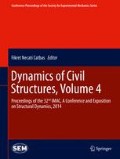Abstract
This paper discusses the seismic response control of a building by connecting it to another adjacent building. Coupled buildings have demonstrated to be an attractive method to mitigate excessive dynamic responses. This paper studies the behavior of two structures connected by passive dampers and also considering local feedback control systems installed in each structure, an hybrid strategy. These feedback control systems are designed and operated independently using active devices with limited actuation capacity like force actuators. The governing differential equations of motion of the coupled system are derived and solved for relative displacement. The advantages and disadvantages of each control strategy are examined in order to determine the more appropriate one. Based on the present research results, general conclusions and recommendations are given for further studies.
Access this chapter
Tax calculation will be finalised at checkout
Purchases are for personal use only
References
Ávila SM (2002) Controle Híbrido para Atenuação de Vibrações em Edifícios. Tese de Doutorado; Departamento de Engenharia Civil PUC-Rio
Palacios-Quiñonero F, Rodellar J, Rossell JM, Pons-López R (2011) Active–passive control strategy for adjacent buildings. In: Proceedings of the 8th international conference on structural dynamics, EURODYN 2011, Leuven
Palacios-Quiñonero F, Rubió-Masse J, Rossell JM, Pons-López R (2011) Active–passive control strategy for adjacent buildings. In: Proceedings of the 8th international conference on structural dynamics, Eurodyn
Patel CC, Jangid RS (2013) Seismic response of dynamically similar adjacent structures connected with viscous dampers. IES J A Civil Struct Eng 3(1):1–13
Christenson RE, Spencer BF Jr, Hori N, Seto K (2003) Coupled building control using acceleration feedback. Comput Aided Civ Infrastruct Eng 18(1):4–18
Klein RE, Cusano C, Stukel J (1972) Investigation of a method to stabilize wind induced oscillations in large structures. In: ASME winter annual meeting, 72-WA/AUT-H, New York
Gurley K, Kareem A, Bergman LA, Johnson EA, Klein RE (1994) Coupling tall buildings for control of response to wind. In: Schueller GI, Shinozuka M, Yao JTP (eds) Structural safety & reliability. Balkema, Rotterdam, pp 1553–1560
Luco JE, Wong HL (1994) Control of the seismic response of adjacent structures. In: Proceedings of the first world conference on structural control, Pasadena, CA, TA2-21-30, August
Christenson RE, Spencer BF Jr, Johnson EA, Seto K (2006) Coupled building control considering the effects of building configurations. ASCE J Struct Eng 132(6):853–863
Bhaskararao AV, Jangid RS (2006) Seismic analysis of structures connected with friction dampers. J Eng Struct 28:690–703
Bigdeli K (2012) Optimal placement and design of passive damper connectors for adjacent structures. Master’s Thesis, University of British Columbia, Vancouver
Kim GC, Kang JW (2011) Seismic response control of adjacent building by using hybrid control algorithm of MR damper. In: The 12th east Asia-Pacific conference on structural engineering and construction, vol 4, pp 1013–1020
Xu YL, He Q, Ko JM (1999) Dynamic response of damper-connected adjacent buildings under earthquake excitation. Eng Struct 21(2):135–148
Zhu H, Ge DD, Huang X (2011) Optimum connecting dampers to reduce the seismic responses of parallel structures. J Sound Vib 333:1931–1949
Zhu HP, Wen Y, Iemura H (2001) A study on interaction for seismic response of parallel structures. Comput Struct 79(2):231–242
Zhang WS, Xu YL (1999) Dynamic characteristics and seismic response of adjacent buildings linked by discrete dampers. Earthq Eng Struct Dyn 28(10):1163–1185
Korkmaz S (2011) A review of active structural control: challenges for engineering informatics. J Comput Struct 89:2113–2132
Wilson EL, Penzien J (2005) Evaluation of orthogonal damping matrices. Int J Numer Methods Eng 5(1):5–10
Soong TT, Dargush GF (1997) Passive energy dissipation systems in structural engineering. Wiley, Chichester
Taylor Devices Inc. http://www.taylordevices.com/pdf/web-damper.PDF
Meirovitch L (1990) Dynamics and control of structures. Wiley, New York
Author information
Authors and Affiliations
Corresponding author
Editor information
Editors and Affiliations
Rights and permissions
Copyright information
© 2014 The Society for Experimental Mechanics, Inc.
About this paper
Cite this paper
Pérez, L.A., Avila, S., Doz, G. (2014). Seismic Response Control of Adjacent Buildings Connected by Viscous and Hybrid Dampers. In: Catbas, F. (eds) Dynamics of Civil Structures, Volume 4. Conference Proceedings of the Society for Experimental Mechanics Series. Springer, Cham. https://doi.org/10.1007/978-3-319-04546-7_46
Download citation
DOI: https://doi.org/10.1007/978-3-319-04546-7_46
Published:
Publisher Name: Springer, Cham
Print ISBN: 978-3-319-04545-0
Online ISBN: 978-3-319-04546-7
eBook Packages: EngineeringEngineering (R0)

